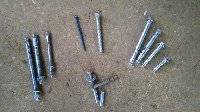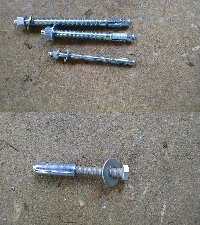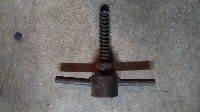What type of concrete anchor to use?
Every once in a while on a construction site here in North Carolina we come across some other persons that also operator core drilling machinery and like all people, we are nosey so we stick around to catch a glimpse of how other core drillers use various core drilling anchoring methods and how they differ from our own when performing the same type of work. We have witnessed just about every type of machine that will run a wet or dry core drill bit to our amazement. this includes the standard stand up rig, wall-mounted rigs, stair mounted rigs, directional rigs that core at almost any angle, and the handy but efficient 4 1/2" grinder that a fellow was using one day that I swore could almost knock out 3-inch core drill holes in a 3rd story concrete floor as fast as we could with a stand-up rig.
Without trying to argue with anyone we would ask why they used drop-in anchors instead of wedge anchors when mounting the base of the coring unit to the wall or floor. The most common reply was because that was what was supplied by the contracting company that employed them. Having met over 300 people in our line of work we don't mind sharing what we believe to be the best and safest way to make a small or large hole in the concrete.
Wedge anchor vs Drop-in anchor
In our opinion the pros of using wedge anchors over drop-in anchors is obvious. A 7-inch by 1/2 inch wedge anchor as pictured is driven into the concrete at least 4-inches. A drop-in anchor, which is not pictured because the boss man does not allow them in the shop or work truck, by comparison, is driven into the concrete by less than 1 1/2" and sometimes less. With a wedge anchor even if the hole to be penetrated is more than head high on a wall and you have to use a ladder, you can still manage to hang the base onto the anchor and then secure the mounting screw and tighten down the rig in place onto the wall. With a drop-in, well your guess is as good as ours. Our advice is to use caution and common sense with any concrete anchoring system that is holding your 140 pounds plus rig to a spot high on any concrete wall.
Tapcons. masonry screws, sleeve anchors
These three types are the other most common concrete anchors that our company uses.
Tapcons or masonry screws utilized correctly can be a great way to hold down your rig while drilling floors, tops of retaining walls, and other vertical holes. Which is a ten-dollar way of saying floors or downward drilling. Great for holding things down, but not up, so Never used masonry screw to attach a rig to a wall.
Sleeve anchors are made to hold things in not-so-solid walls such as cement block and brick. Though a single wedge anchor might do the trick when coring a solid concrete wall, it is our advice that when coring a brick or block wall to use more than one sleeve anchor to hold the weight of the rig, motor and bit along with the additional weight of the water hose and electrical setup for the control panel. If possible use a larger 4 to 6 inch by 1/2 inch size anchor in the middle slot and a smaller 3-inch by 3/8 inch or, maybe 1/2 inch by 4-inch if you are able to do so where the leveling hole bolts are typically found.
Vacuum pumps and Roof jacks
Most modern core drilling rigs come with a funny-looking screw top on the tip of the mast that can be confusing. It usually has a metal point to it and you may wonder what on earth it is for. It is for using a 4 x 4 piece of lumber to act as a clamp between solid concrete floors on multi-story buildings. You place the core drill where the hole needs to go, measure just a bit short of how tall the concrete ceiling above is, cut your 4 x 4 lumber and stick it on top of the point part of the jack and begin screw clockwise to tighten the core drill rig down to the floor you are standing on.
Vacuum pumps use rubber seals around the base and a vacuum module that suck the rig down to the concrete and probably the most common method of anchoring a core drill rig to most concrete floors.




